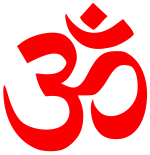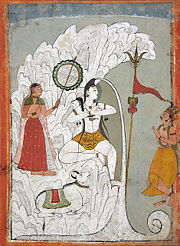Ganga in Hinduism
|
Part of a series on |
 |
|
Beliefs and practices
Dharma · Artha · Moksha · Karma · Samsara |
|
Scriptures
Vedas |
|
Related topics
Hinduism by country |
|
|
In Hinduism, the river Ganga (Sanskrit and Hindi गंगा Gaṅgā) or Ganges River (as called by westerners) is considered sacred. It is worshipped by Hindus, and personified as a goddess in Hinduism, who holds an important place in the Hindu religion. Hindus believe that bathing in the river on certain occasions causes the remission of sins and facilitates the attainment of salvation. Many people believe that this effect obtains from bathing in Ganga at any time. People travel from distant places to immerse the ashes of their kin in the waters of the Ganga; this immersion also is believed to be meritorious as the ashes are believed to go to heaven. Several places sacred to Hindus lie along the banks of the river Ganga, including Haridwar, Allahabad and Varanasi.
Contents |
Birth

There are several Hindu beliefs that give various versions of the birth of Ganga. According to one version, the sacred water in Brahma's Kamandalu (water-vessel) became personified as a maiden, Ganga. According to another (Vaishnavite) legend, Brahma had reverently washed the feet of Vishnu and collected this water in his Kamandalu. According to yet a third version, Ganga was the daughter of Himavan, king of the mountains, and his consort Mena; she was thus a sister of the goddess Parvati. Every version declares that she was raised in the heavens, under the tutelage of Brahma.
Descent to Earth

Several years later, a king named Sagara magically acquired sixty thousand sons. One day, King Sagara performed a ritual of worship for the good of the kingdom. One of the integral parts of the ritual was a horse, which was stolen by the jealous Indra. Sagara sent all his sons all over the earth to search for the horse. They found it in the nether-world (or Underworld) next to a meditating sage Kapila. Believing that the sage had stolen the horse, they hurled insults at him and caused his penance to be disturbed. The sage opened his eyes for the first time in several years, and looked at the sons of Sagara. With this glance, all sixty thousand were burnt to death.
The souls of the sons of Sagara wandered as ghosts since their final rites had not been performed. When Bhagiratha, one of the descendants of Sagara, son of Dilip, learnt of this fate, he vowed to bring Ganga down to Earth so that her waters could cleanse their souls and release them to heaven.
Bhagiratha prayed to Brahma that Ganga come down to Earth. Brahma agreed, and he ordered Ganga to go down to the Earth and then on to the nether regions so that the souls of Bhagiratha's ancestors would be able to go to heaven. The vain Ganga felt that this was insulting and decided to sweep the whole earth away as she fell from the heavens. Alarmed, Bhagiratha prayed to Shiva that he break up Ganga's descent.

Ganga arrogantly fell on Shiva's head. But Shiva calmly trapped her in his hair and let her out in small streams. The touch of Shiva further sanctified Ganga. As Ganga travelled to the nether-worlds, she created a different stream to remain on Earth to help purify unfortunate souls there. She is the only river to follow from all the three worlds - Swarga (heaven), Prithvi (earth) and, Patala (neitherworld or hell). Thus is called "Tripathagā" ( one who travels the three worlds) in Sanskrit language.
Because of Bhagiratha's efforts Ganga descended on to earth and hence the river is also known as Bhagirathi, and the term "Bhagirath prayatna" is used to describe valiant efforts or difficult achievements.
Another name that Ganga is known by is Jahnavi. Story has it that once Ganga came down to earth, on her way to Bhagiratha, her rushing waters created turbulence and destroyed the fields and the sadhana of a sage called Jahnu. He was angered by this and drank up all of Ganga's waters. Upon this, the Gods prayed to Jahnu to release Ganga so that she could proceed on her mission. Pleased with their prayers, Jahnu released Ganga (her waters) from his ears. Hence the name "Jahnavi" (daughter of Jahnu) for Ganga.
It is sometime believed that the river will finally dry up at the end of Kali Yuga (the era of darkness, the current era) just as with the Sarasvati river, and this era will end. Next in (cyclic) order will be the Satya Yuga or the era of Truth.
Other Mythological Associations

According to the Hindu scriptures like Skanda Purana, the goddess Ganga is foster-mother to Karttikeya (Murugan), who was actually a son of Shiva and Parvati.
Parvati who created an image of Ganesha (the second son of Shiva and Parvati) out of her bodily impurities but which became endowed with life after immersion in the sacred waters of the Ganga. Therefore Ganesha is said to have two mothers--Pārvati and Gangā and hence called Dvaimātura and also Gāngeya (the son of Ganga).[1]
According to Brahma Vaivarta Purana 2.6.13-95 Vishnu has three wives, who constantly quarrel with each other, so that eventually, he keeps only Lakshmi, giving Ganga to Shiva and Saraswati to Brahma.
The Hindu epic, Mahābhārata tells that the Vasus, cursed by Vashishta had requested Ganga to be their mother. Ganga incarnated and became the wife of King Santanu on condition that at no stage shall he question her actions, or she would leave him.. As seven Vasus were born as their children, one after the other, Ganga drowned them in her own waters, freeing them from their punishment and the king made no opposition. Only when the eighth was born did the king finally oppose his wife, who therefore left him. So the eighth son, Dyaus incarnated, remained alive, imprisoned in mortal form, and later became known in his mortal incarnation as Bhishma (Devavrata), who is one of the most respected characters of the Mahābhārata.
Rig Veda
The Ganga is definitely mentioned in the Rig-Ved, the earliest and theoretically the holiest of the Hindu scriptures. The Ganga is mentioned in the nadistuti (Rig Veda 10.75), which lists the rivers from east to west. In RV 6.45.31, the word Ganga is also mentioned, but it is not clear if the reference is to the river.
RV 3.58.6 says that "your ancient home, your auspicious friendship, O Heroes, your wealth is on the banks of the Jahnavi (JahnAvyAm)". This verse could possibly refer to the Ganga.[2] In RV 1.116.18-19, the Jahnavi and the Gangetic dolphin occur in two adjacent verses.[3][4]
Iconography
In the canons of Indian art, Ganga is visualized as voluptuous and beautiful, carrying an overflowing pot in her hand. The vessel conveys the idea of abundant life and fertility, which nourishes and sustains the universe.
The second distinguishing aspect of Ganga's iconography is her animal mount, which is often shown serving as a pedestal for her. This is the makara, a hybrid creature having the body of a crocodile and the tail of a fish. The makara in Hindu thought corresponds to the star sign of Capricorn in western astrology.
The makara is also the vehicle of the Vedic god of waters, Varuna, thus establishing firmly Goddess Ganga's Vedic roots.
Notes
- ↑ Y. Krishan (Gaṇeśa:Unravelling an Enigma, p.6
- ↑ Talageri, Shrikant. (2000) The Rigveda: A Historical Analysis; Talageri, S.: "Michael Witzel - An examination of his review of my book". --Griffith translates JahnAvyAm in this verse as "house of Jahnu", even though in similar verses he uses the "on the banks of a river" translation (see Talageri 2000)
- ↑ Talageri, Shrikant. (2000) The Rigveda: A Historical Analysis.; Talageri, S.: "Michael Witzel - An examination of his review of my book" 2001.
- ↑ The Sanskrit term shimshumara refers to the Gangetic dolphin (the Sanskrit term for dolphin is shishula). Talageri 2000, 2001
External links
- The Life Of Ganga
- Sacred Ganga
- Ganga Arati Video Quicktime streaming video of worship of the Ganges in Hardwar (15 minutes)
- Various Aspects Of Ganges
- The Mystic Ganga
|
|||||||||||
